SURVEYS FOR A RARE PHEASANT ON CHINAíS SOUTHWESTERN FRONTIER
Off-limits for decades, American scientists help determine the status of one
of the regionís rarest pheasants
James D. Bland, Santa Monica College
David S. Rimlinger, Curator of Birds, Zoological Society of
San Diego
We huddled around our campfire,
growing increasingly restless as fog, rain, and gusting winds continued to
plague our expedition. Two days earlier our guides had led us through dense
rhododendron and bamboo forest to this
 12,000
foot ridge, a fairytale landscape made more alluring by a persistent fog that
kept the surrounding terrain a mystery. Our desolate campsite, perched on a
ridge separating the great Salween and Mekong rivers was a prime spot, our
guides assured us, to encounter Sclaterís Monal, a resplendent and
little-known pheasant of the far eastern Himalaya.
12,000
foot ridge, a fairytale landscape made more alluring by a persistent fog that
kept the surrounding terrain a mystery. Our desolate campsite, perched on a
ridge separating the great Salween and Mekong rivers was a prime spot, our
guides assured us, to encounter Sclaterís Monal, a resplendent and
little-known pheasant of the far eastern Himalaya.
The winds that had buffeted our tents suddenly
settled, and the diffuse light around our makeshift camp brightened as though
someone had raised a dimmer switch. A portal opened in the wall of clouds before
us, and a vignette of startlingly beautiful landscape was slowly revealed.
Through the portal
 we
saw vast fields of wildflowers, dark and glistening from the recent rains. A
steep canyon came into view directly below us, and on the opposite bank we could
see a magnificent alpine lake nestled among craggy peaks. Far beyond we could
see the sun-drenched croplands of the Mekong Valley.
we
saw vast fields of wildflowers, dark and glistening from the recent rains. A
steep canyon came into view directly below us, and on the opposite bank we could
see a magnificent alpine lake nestled among craggy peaks. Far beyond we could
see the sun-drenched croplands of the Mekong Valley.
Our window through the clouds then closed as abruptly as it had opened.
Dulcet light returned to our camp, and we retreated to our tents. The brief
respite from bad weather had raised our spirits nonetheless. We might awaken to
clear skies in the morning and begin our long-awaited investigation of the area.
As we settled in for the night we remained
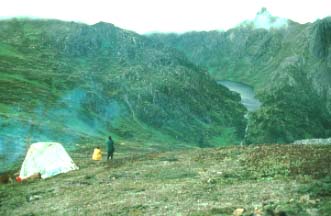 ambivalent over whether we were in
the company of monal. If they were here, wouldnít they have greeted todayís
spectacular break in weather with a bout of song?
ambivalent over whether we were in
the company of monal. If they were here, wouldnít they have greeted todayís
spectacular break in weather with a bout of song?
This camp was the last of three where we surveyed Sclaterís Monal. All
three were near the eastern limit of the speciesí range, which extends from
western Yunnan to northeastern India, including northern Myanmar (Burma) and
southeastern Tibet. Taken together, our three sites represented an unprecedented
sample of monal habitats across the speciesí range in Yunnan. We two
foreigners were very aware of the unique opportunity this expedition
represented. The areas we visited had only been open to foreign travelers for a
few years, and monal habitats beyond this area remained exceedingly difficult if
not impossible to visit.
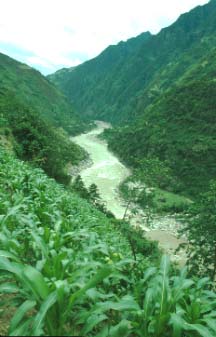 We
were at the very heart of Yunnanís Great Rivers area, known as "the
hump" in wartime lore, one of the most distinctive surface features of any
raised-relief world map. Here, the deep canyons of the Irrawaddy, Salween,
Mekong and Yellow Rivers closely parallel one another, separated by narrow but
lofty mountain ranges. The few Western scientists who preceded us here were a
stalwart lot indeed; the likes of plant-hunter Joseph Rock whose authorization
to travel in the 1920s and 30s came in the form of an armed, mounted, retinue.
We
were at the very heart of Yunnanís Great Rivers area, known as "the
hump" in wartime lore, one of the most distinctive surface features of any
raised-relief world map. Here, the deep canyons of the Irrawaddy, Salween,
Mekong and Yellow Rivers closely parallel one another, separated by narrow but
lofty mountain ranges. The few Western scientists who preceded us here were a
stalwart lot indeed; the likes of plant-hunter Joseph Rock whose authorization
to travel in the 1920s and 30s came in the form of an armed, mounted, retinue.
The objectives of our expedition were three-fold: to assess the range of
habitats Sclaterís Monal occupy across Yunnan, to compare densities of monal
under different habitat conditions, and to identify a good location for future
long-term ecological studies of the species. We were joined by staff of the
Ornithological and Mammalogy Sections of the Kunming Institute of Zoology, our
host institution in China.
We began our fieldwork in early May, 1999, on a network of alpine meadows
known as Da Yang Tian, near the southern limit of the monalís know distribution
in Yunnan. David had not joined us yet, so Yang Xiaojun and I were co-leaders of
the first survey. Da Yang Tian had gained recent recognition among globe-trotting
bird watchers as a relatively easy place to see Sclaterís Monal in the wild,
something few Westerners have achieved. It was raining lightly when we
arrived at Da Tang Field Station, at the base of the
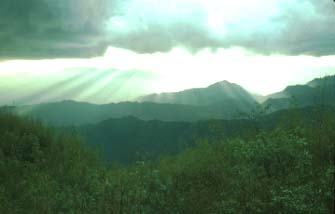 Gaoligong
Mountains. Our local hosts and the local men who gathered to assist us were
doubtful that we really intended to camp in the rain for ten days. Their prior
experience with Western visitors suggested we would head back down the mountain
soon after we observed our first monal.
Gaoligong
Mountains. Our local hosts and the local men who gathered to assist us were
doubtful that we really intended to camp in the rain for ten days. Their prior
experience with Western visitors suggested we would head back down the mountain
soon after we observed our first monal.
The meadows of Da Yang Tian were a full dayís walk uphill from Da Tang Station.
Negotiations that lasted late into the evening produced a full crew of horsemen
at our doorstep the following morning,
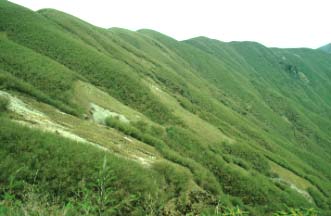 ready
to haul our supplies and assist us in the field. At the lower boundary of
Gaoligong Nature Reserve we entered lush rhododendron forest with a bamboo
understorey. The forest floor was strewn with fallen rhododendron flowers.
ready
to haul our supplies and assist us in the field. At the lower boundary of
Gaoligong Nature Reserve we entered lush rhododendron forest with a bamboo
understorey. The forest floor was strewn with fallen rhododendron flowers.
Most of our team camped at the upper limit of closed-canopy forest, where
they would study small mammals. Xiaojun and I continued on to monal habitats
with a small tent, spotting scopes, and a bare minimum of supplies. At 10,800
feet elevation we emerged from closed-canopy forest onto an extensive network of
meadows surrounded by dense bamboo thicket. From our elevated vantage point we
could see that tall mixed broadleaved forest extended up to about 9,000 feet
elevation, and above that bamboo thickets dominated. Below about 11,500 feet
elevation the bamboo thickets included a minor broadleaf shrub component. Above
11,500 feet , where most alpine meadows occurred, the broadleaf component was
essentially absent from the bamboo thickets. We could also see that Da Yang Tian comprised one of the most extensive alpine habitats in
the entire southern Gaoligong
Range.
We spent the next nine days surveying the meadows of Da Yang Tian, working from a
series of bivouacs along the crest of the main ridge. In essence we conducted a
line survey in slow motion. Every second day or so we relocated our camp several
hundred yards further along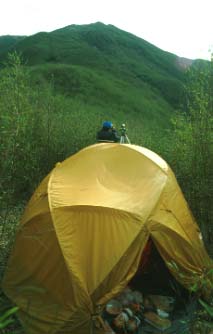 the ridge. Before first light we would enter a makeshift blind positioned where
it provided a wide view of the surrounding terrain and begin watching and
listening for monal. Weather permitting, we would spent four hours observing from
blinds in the morning and in the afternoon. When monal appeared we would
document every move and vocalization and try to piece together an understanding
of their life ways from such fleeting glimpses. When monal were not present,
other natural dramas usually unfolded before us; lesser pandas sauntering across
meadows or mixed-species flocks of songbirds passing through the bamboo within
armís reach.
the ridge. Before first light we would enter a makeshift blind positioned where
it provided a wide view of the surrounding terrain and begin watching and
listening for monal. Weather permitting, we would spent four hours observing from
blinds in the morning and in the afternoon. When monal appeared we would
document every move and vocalization and try to piece together an understanding
of their life ways from such fleeting glimpses. When monal were not present,
other natural dramas usually unfolded before us; lesser pandas sauntering across
meadows or mixed-species flocks of songbirds passing through the bamboo within
armís reach.
The behavior of the first male we observed was typical of the other males we
observed in late spring. Xiaojun first spotted the hen-sized bird perched
motionless on a stone near the edge of a meadow. It remained absolutely still
for several minutes, looking directly toward us, head in an erect alert
position. His jet black breast and belly made him stand out against the lush
green meadow. With spotting scopes we could see
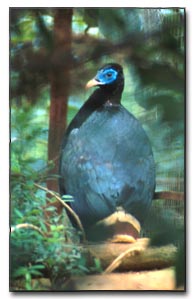 a
cobalt blue "saddle" of skin covering much of his face, and an
iridescent gold patch of feathers on the back of his neck. He then walked
briskly and purposefully down slope, nipping at a grass shoot with every few
strides. After descending a few meters he resumed a stoic pose, his gaze fixed
somewhere across the sprawling canyon that lay before him. With no apparent
provocation he took flight, flapping his wings stiffly initially and calling a
staccato "toop-totoop-toop-toop." He landed a few hundred yards away
on a prominent outcrop and uttered a rapid series of up-slurred whistles, "toop-toop-toop-toop."
We watched his oversized beak spring up comically with each note. Eventually he
disappeared into the bamboo, occasionally giving the speciesí characteristic
"gu-li" call.
a
cobalt blue "saddle" of skin covering much of his face, and an
iridescent gold patch of feathers on the back of his neck. He then walked
briskly and purposefully down slope, nipping at a grass shoot with every few
strides. After descending a few meters he resumed a stoic pose, his gaze fixed
somewhere across the sprawling canyon that lay before him. With no apparent
provocation he took flight, flapping his wings stiffly initially and calling a
staccato "toop-totoop-toop-toop." He landed a few hundred yards away
on a prominent outcrop and uttered a rapid series of up-slurred whistles, "toop-toop-toop-toop."
We watched his oversized beak spring up comically with each note. Eventually he
disappeared into the bamboo, occasionally giving the speciesí characteristic
"gu-li" call.
We surmised from our observations that male monals at Da Yang Tian were not very
territorial at this season. Their courtship season was over, and their mates
were probably all setting on nests. We noted that males often flew cross-slope
several hundred yards and landed where we had seen or heard other males, but the
vocalizations of recently arrived individuals did not elicit a vocal response
from the males already present.
When we werenít in blinds or relocating camp we turned our attention to the
local vegetation. We found that elevation differences of a few hundred yards
influenced plant growth dramatically. At the tops of sloping meadows herbaceous
plants were just emerging from winter dormancy, while 200 yards below they had
formed a flowering carpet a foot deep or more. The earliest species to emerge
included sedges, grasses, and bulb-forming monocots, followed a few weeks later
by a wide variety of flowing herbs.
The monsoon rains returned on May 13th, after only 4 days of
unimpeded fieldwork. The attending wind and fog made monal observation virtually
impossible. When we were hampered only by fog we busied ourselves collecting
plants, with condensation dripping from the brims of our hats in a steady
stream. On one occasion, frustrated by our
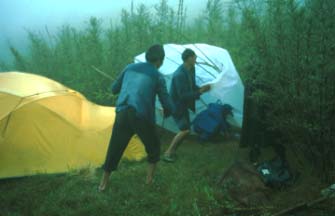 inability
to look for monal in additional locations, we spent a full 2 hours sitting in
drizzling rain, listening for monal. We didnít hear anything, and we got
thoroughly soaked. We tried to dry out next to a smoky bamboo fire, but with
humidity above 95% we found that it was more effective to just wear our clothes
until they dried from body heat.
inability
to look for monal in additional locations, we spent a full 2 hours sitting in
drizzling rain, listening for monal. We didnít hear anything, and we got
thoroughly soaked. We tried to dry out next to a smoky bamboo fire, but with
humidity above 95% we found that it was more effective to just wear our clothes
until they dried from body heat.
After 5 days of rain and fog with little productive work accomplished, our
planned departure day had arrived. Three porters emerged from the fog and
drizzle to help us carry our supplies off the mountain. It was clear that a
springtime study of Sclaterís Monal would require special monsoon-worthy
equipment and a unique approach to data collection.
Back at the forest camp our colleagues informed us that American aircraft had
bombed the Chinese Embassy in Belgrade, killing 3 Chinese citizens. Their
opinion appeared to be unanimous, another case of the United States
government bullying the Chinese.
Back at Da Tang, soaking in a local hot spring, we were able to review the
merits of Da Yang Tian as a potential long-term study site. On the plus side, there
was relatively easy access and an abundance of other interesting wildlife,
including lesser pandas, takins, tufted deer, black bears and blood pheasants.
Local authorities had been very hospitable, and our local field help had been
reasonably good under the circumstances. On the down side, the extent of monal
habitat and numbers of monal appeared to be quite limited.
In route to our next destination, Gongshan, we stopped at Tengchong, which we
learned was the northernmost advance of the Japanese Army into Yunnan during the
Second World War. The city was occupied for more than 2 years, beginning in
1942. In 1944 Chinese forces and local militia turned back the Japanese in a
decisive battle on the slopes of the Gaoligong , not far from Da Yang Tian. The
American military had assisted by air-dropping war supplies, a campaign that took
the lives of fourteen American soldiers.
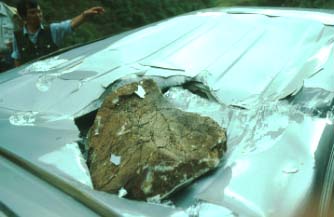 We
experienced a different sort of air-drop as we traveled to Gongshan. As we drove
along a tributary of the Salween River, a 150 pound boulder slid off a sheer
canyon wall and pierced through the roof of our Landcruiser with a bang and
shudder that had us believing a tire had exploded. Amazingly, no one was
injured. The rock had penetrated near the rear of the vehicle, crushing only
some luggage. Back home the mangled Landcruiser would have been considered a
total loss, but local mechanics straightened and calked the roof and had us back
on the road within a few days.
We
experienced a different sort of air-drop as we traveled to Gongshan. As we drove
along a tributary of the Salween River, a 150 pound boulder slid off a sheer
canyon wall and pierced through the roof of our Landcruiser with a bang and
shudder that had us believing a tire had exploded. Amazingly, no one was
injured. The rock had penetrated near the rear of the vehicle, crushing only
some luggage. Back home the mangled Landcruiser would have been considered a
total loss, but local mechanics straightened and calked the roof and had us back
on the road within a few days.
We reached Ci Kai, the county seat of Gongshan County, on May 23rd. Ci Kai was the nearest market town to our northernmost survey site,
Dong Shao Fang.
Monal had been collected at Dong Shao Fang in years past, and a well-established
trail would provide easy access to alpine elevations.
We visited a public horse stall on the outskirts of town with the intention
of hiring a horse team. Not a single horse was present. The stall keepers
explained that recent rains had raised the level of the Pula River over some key
trails, and all the horse teams were held up in the mountains. We would have to
wait until the rains subsided.
Our first full day in Ci Kai was, by good fortune, market day, so we set out
to buy food supplies, sheet plastic, rope, and rubber boots. Later in the day we
met a ragtag party of horsemen perusing the market. The Pula had receded and
they had just arrived in town. The demand for horse teams was high, they said,
and their rates would be
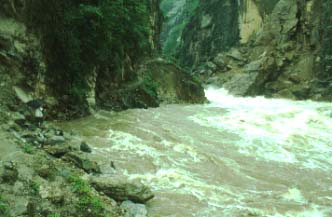 correspondingly
high. As was the practice, negations over prices proceeded late into the
evening, and the following morning six ponies arrived at our hotel. The trail we
departed town on was, if fact, the main trail to Dulong. Dulong, we were told,
was the last county seat in all of China without a road. Although cobblestone
had been laid along much of the trail, recent rains and heavy horse traffic had
made it a filthy, mucky, mess, which we had no choice but to wade through.
Twenty minutesí walk from Ci Kai the trail ended abruptly at the base of a
sheer cliff, inundated by the raging Pula River. Even if we dared wade the 30
foot stretch of flooded trail, our ponies could not. An alternate trail was not
passable by horses at all, so we had no choice but to return to our hotel and
wait for the Pula to recede. As locals had suggested, the river receded after a
few hours and we were able to proceed.
correspondingly
high. As was the practice, negations over prices proceeded late into the
evening, and the following morning six ponies arrived at our hotel. The trail we
departed town on was, if fact, the main trail to Dulong. Dulong, we were told,
was the last county seat in all of China without a road. Although cobblestone
had been laid along much of the trail, recent rains and heavy horse traffic had
made it a filthy, mucky, mess, which we had no choice but to wade through.
Twenty minutesí walk from Ci Kai the trail ended abruptly at the base of a
sheer cliff, inundated by the raging Pula River. Even if we dared wade the 30
foot stretch of flooded trail, our ponies could not. An alternate trail was not
passable by horses at all, so we had no choice but to return to our hotel and
wait for the Pula to recede. As locals had suggested, the river receded after a
few hours and we were able to proceed.
 On the trail to
Dong Shao Fang we camped at two government rest houses, the second a positively
filthy, dilapidated, hovel with all the charm of a Siberian prison camp. We
arrived at our proposed campsite at 11,500 feet in a frigid, wind-blown,
downpour. Most of our horsemen had dumped their loads several hundred yards
short of camp and departed without a word. Those that remained nearly abandoned
us amid the chaos of establishing camp in a storm.
On the trail to
Dong Shao Fang we camped at two government rest houses, the second a positively
filthy, dilapidated, hovel with all the charm of a Siberian prison camp. We
arrived at our proposed campsite at 11,500 feet in a frigid, wind-blown,
downpour. Most of our horsemen had dumped their loads several hundred yards
short of camp and departed without a word. Those that remained nearly abandoned
us amid the chaos of establishing camp in a storm.
Rain and fog persisted for the next 5 days, largely restricting us to our
tents or the kitchen lean-to. The steep slopes encircling our camp were
transformed into cascades of streamlets and waterfalls. The saturated canyon
floor took on the distinct character of an arctic muskeg. In one 24-hour period
we recorded 3.2 inches of rainfall.
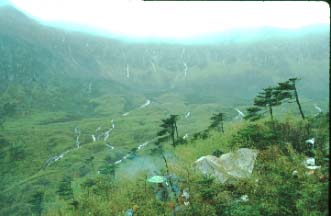 On May 30th the rain and fog subsided enough for us to check the
nearby 12,000 foot pass for signs of monal. We sat in a drizzling mist at the
edge of a flower-studded meadow, hoping to hear the call of a monal. Our vision was limited to less
than 200 feet by fog. After about 20 minutes Xiaojun and our guide motioned that
they had heard a monal. We all waited patiently to hear it a second time, but
the storm intensified and we were forced to return to camp.
On May 30th the rain and fog subsided enough for us to check the
nearby 12,000 foot pass for signs of monal. We sat in a drizzling mist at the
edge of a flower-studded meadow, hoping to hear the call of a monal. Our vision was limited to less
than 200 feet by fog. After about 20 minutes Xiaojun and our guide motioned that
they had heard a monal. We all waited patiently to hear it a second time, but
the storm intensified and we were forced to return to camp.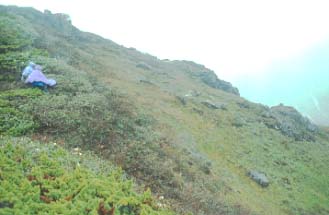
The terrain at Dong Shao Fang had much in common with what we had seen at Da Yang Tian, but there was a more significant shrub component, bamboo thickets were
less extensive, and rock outcrops more widespread. The dominant herbaceous
plants were similar, but there appeared to be a greater diversity here. The most
striking difference was in the level of human disturbance. The meadows of Dong Shao Fang
were within easy reach of a heavily traveled trail, so large
animals in the area would fall easy prey to anyone passing by with a gun. It was
no wonder we had not see a single large or medium-sized mammal at Dong Shao Fang.
The following day we departed Dong Shao Fang. After descending a thousand feet
or so we looked back to find a gray wall of fog descend rapidly toward us, as if
to usher us out of the canyon. We took it as a final, poignant, reminder that
this irascible landscape will not give up its secrets without difficulty.
Back in the relative comfort of our hotel room we discussed the merits of Dong Shao Fang
as a potential long-term study site. Dong Shao Fang itself was out
of the question. Convenient yes, maybe even good habitat, but too highly
disturbed. And the amazing amount of rainfall was a serious obstacle. Local
authorities had been very helpful, but local laborers had been less than
sterling. It would have been worthwhile to investigate a less disturbed site in
the general area, but the time we had allotted to Gongshan County had run out.
We needed to proceed to Fugong County.
David Rimlinger joined us in early June at a dilapidated lumber town called
Zhiziluo, central Fugong County. Many Sclaterís Monal had been collected by Chinese
scientists from this general area. This would be our central survey site,
approximately midway between Da Tang and Dong Shao Fang.
 The village leader of Zhiziluo called upon two former monal hunters to be our
guides. Both had worked on previous monal studies. We discussed our plans over
dinner, the first meal they had ever
shared with Westerners. Our guides, Mr. HŽ and Mr. ShŽ, were humble gentlemen,
both lean and bronze-skinned farmers. They said they had not hunted monal for 4
or 5 years. Rather, they had been employed by a private lumber company to help
harvest the areaís pristine forests.
The village leader of Zhiziluo called upon two former monal hunters to be our
guides. Both had worked on previous monal studies. We discussed our plans over
dinner, the first meal they had ever
shared with Westerners. Our guides, Mr. HŽ and Mr. ShŽ, were humble gentlemen,
both lean and bronze-skinned farmers. They said they had not hunted monal for 4
or 5 years. Rather, they had been employed by a private lumber company to help
harvest the areaís pristine forests.
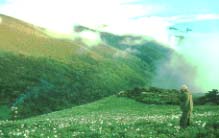 The
location above Zhiziluo where we had experienced the "parting of the
clouds" was a site Xiaojun had visited on a 1997 reconnaissance trip. Back
again, the five of us, three researchers and two guides, endured foul weather on
the summit for 3 full days. On the fourth day we moved camp down to the upper limit
of trees, where we had observed what we believed were monal fecal droppings. On
our way to the new campsite we practically stumbled over a female monal with
three two-week-old chicks. The hen disappeared into nearby rhododendron
thickets, but the chicks climbed the base of a dead shrub to get a better view
of us.
The
location above Zhiziluo where we had experienced the "parting of the
clouds" was a site Xiaojun had visited on a 1997 reconnaissance trip. Back
again, the five of us, three researchers and two guides, endured foul weather on
the summit for 3 full days. On the fourth day we moved camp down to the upper limit
of trees, where we had observed what we believed were monal fecal droppings. On
our way to the new campsite we practically stumbled over a female monal with
three two-week-old chicks. The hen disappeared into nearby rhododendron
thickets, but the chicks climbed the base of a dead shrub to get a better view
of us.
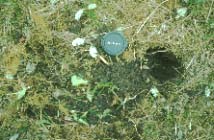 The
following morning we searched the area and found fresh monal fecal droppings and
partially eaten herbs. Monal feed primarily on the young shoots and underground
parts of herbaceous plants, so they usually churn up the soil where they dine.
They also leave distinctive impressions of their spade-shaped beaks where they
have dug for food.
The
following morning we searched the area and found fresh monal fecal droppings and
partially eaten herbs. Monal feed primarily on the young shoots and underground
parts of herbaceous plants, so they usually churn up the soil where they dine.
They also leave distinctive impressions of their spade-shaped beaks where they
have dug for food.
We continued north along a contour until we reached the crest of a prominent
spur where there was a sharp transition from shrub to meadow vegetation. We
hiked upslope along this edge to 12,500 feet elevation, where we noticed what
looked like an unusual kind of soil erosion or patterned ground. On closer
inspection we saw that the mossy crust of the soil had been turned over in 1 to
2 inch squares. When we found fresh monal droppings and deeply-excavated pits we
realized we had
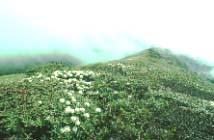 stumbled
upon a site where a considerable number of monal had been feeding as recently as
the previous day. The diggings extended for several hundred yards up the crest
of the spur.
stumbled
upon a site where a considerable number of monal had been feeding as recently as
the previous day. The diggings extended for several hundred yards up the crest
of the spur.
Monal are "sloppy eaters," so it was easy to determine what they
had eaten from the "table scraps" they had left behind. In addition to
eating herbaceous plants, there was strong evidence that the monal had
splintered apart decaying woody stems in pursuit of wood-boring insect larvae.
David was delighted to find examples of a fungus-infected
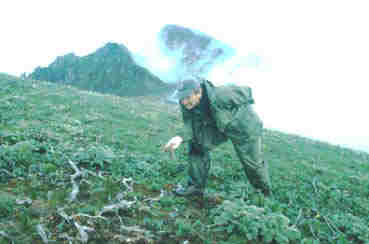 caterpillar
in pits dug by monal. The "dong chong xia cao" is a popular and
expensive traditional Chinese medication that David had previously determined to
be a possible food item of the rare Chinese Monal in Sichuan (Zoonooz,
April 1995).
caterpillar
in pits dug by monal. The "dong chong xia cao" is a popular and
expensive traditional Chinese medication that David had previously determined to
be a possible food item of the rare Chinese Monal in Sichuan (Zoonooz,
April 1995).
From our treasure-trove of monal table scraps we could hear raised voices and
the clang of pots and pans emanating from our camp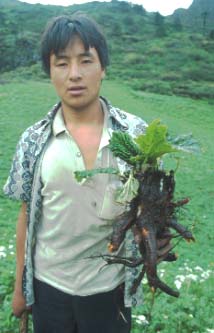 below. Our porters had arrived on schedule, and it was time to depart. As we
made our way down slope our porters collected medicinal herbs around camp. This
was a well-known site for collecting herbs, and the opportunity to collect herbs
contributed to the portersí interest in working for us. They displayed their
harvest to us happily. Included were "ta huang" (wild rhubarb), and
"bei mu" (fritillary).
below. Our porters had arrived on schedule, and it was time to depart. As we
made our way down slope our porters collected medicinal herbs around camp. This
was a well-known site for collecting herbs, and the opportunity to collect herbs
contributed to the portersí interest in working for us. They displayed their
harvest to us happily. Included were "ta huang" (wild rhubarb), and
"bei mu" (fritillary).
Back in the comforts of "civilization" we were able to consider all we
had learned about Sclaterís Monal. The early onset of the monsoon robbed us of
many productive days in the field, and our Chinese hosts had struggled with the difficult survey
protocol we had tried, but we learned a considerable amount
about this hitherto poorly known species nonetheless.
So far as we could determine, Sclaterís Monal persist throughout their
historic range in Yunnan. We even received unconfirmed reports that the species
occurs even further south than currently recognized. The speciesí occurrence
on discontinuous mountain summits, however, could imply it is vulnerable to
local extinction. This is especially true in the south, where alpine habitats
occur as isolated islands and local populations may consist of as few as a
dozen individuals. According to metapopulation theory, the extirpation of local
populations through overhunting or other disturbance could threaten the
viability of neighboring subpopulations as well.
As for our own surveys, we encountered between three and five adult males at Da Yang Tian, one vocalizing individual at
Dong Shao Fang, and one female with three
chicks at Zhiziluo. Unfortunately, bad weather and our failure to fully
implement the intended study design leave us with no means to quantitatively
compare the abundance of monal at the three sites we visited. We canít be
certain of the number of males at Da Yang Tian because there is a chance we
observed some of the same individuals more than once. The most likely reason we
didnít see any females at Da Yang Tian is that we were there during the nesting
season. There were many more individuals at Zhiziluo than we actually saw, but
we have no idea how many. We suspect the season that these birds frequently vocalize
may have passed by the time we arrived there in June.
We documented several environmental features that were typical of the
breeding season habitats we visited. The monal we encountered were found on
large meadows or meadow complexes that extended several hundred yards
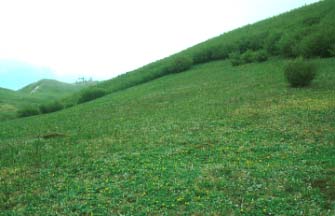 down
steep slopes. The meadows were surrounded by bamboo or rhododendron thickets,
and there were at least a few rock outcrops present. The lowest elevation we
observed such meadows, as well as monal, was about 10,000 feet. By summer,
meadows below 12,000 feet supported a lush and colorful carpet of flowering
plants, grasses, and sedges. Some of the flowering
down
steep slopes. The meadows were surrounded by bamboo or rhododendron thickets,
and there were at least a few rock outcrops present. The lowest elevation we
observed such meadows, as well as monal, was about 10,000 feet. By summer,
meadows below 12,000 feet supported a lush and colorful carpet of flowering
plants, grasses, and sedges. Some of the flowering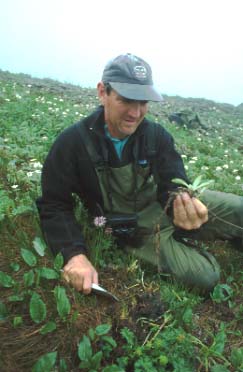 plants we observed consistently included cinquefoil (Rosaceae), buttercup (Ranunculaceae),
fritillary (Liliaceae), jack-in-the-pulpit (Araceae), and peony (Rosaceae). A
surprising abundance of bulb-forming monocots also occurred within the thickets
of bamboo and rhododendron.
plants we observed consistently included cinquefoil (Rosaceae), buttercup (Ranunculaceae),
fritillary (Liliaceae), jack-in-the-pulpit (Araceae), and peony (Rosaceae). A
surprising abundance of bulb-forming monocots also occurred within the thickets
of bamboo and rhododendron.
We noted several habitat features that varied along the north-south axis of
the monalís Yunnan distribution. The mountain ranges of the region achieve
greater elevations
further north, so at more northerly locations alpine habitats tend to be more
contiguous and more rocky. Rainfall is higher further north, so the vegetation
tends to be more muskeg-like further north. Finally, at more northerly locations
there was a greater broadleaf component to the alpine thickets.
The "table scraps" that monal left behind indicated they eat the
stems and roots of cinquefoil, buttercup, jack-in-the-pulpit, and fritillary.
Circumstantial evidence suggests they also eat grass shoots, a small
bulb-forming member of the carrot family, beetle larvae, and the larvae of
wood-boring insects. The birds we observed seldom foraged more than a few yards
from the edge of bamboo or broadleaf thickets.
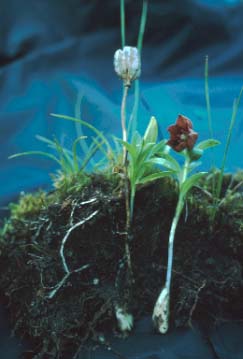
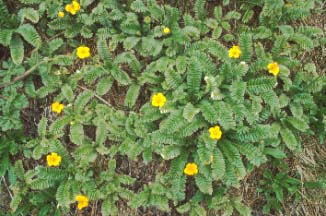
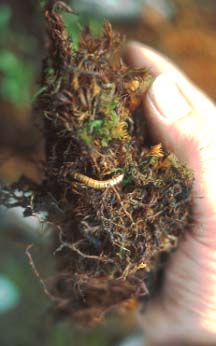
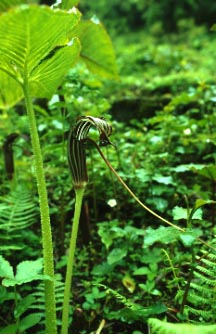
Another important objective we achieved was to choose a future long-term
study site. We chose Zhizilou for its diverse mosaic of habitat types, a
branching ridge system that would facilitate radio-telemetry, the availability
of expert and congenial guides, and an apparent abundance of monal. The research
we propose to begin next would include an in-depth ecological study of Sclaterís
Monal as well as an assessment of the impact of market hunting on
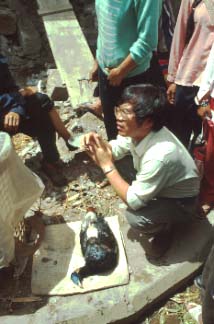 all
pheasant species of northwest Yunnan. Illegal market hunting may pose a
significant threat to Sclaterís Monal. In our travels we encountered two dead
monal for sale in outdoor markets. Even though the species receives the same
protected status as giant pandas, monal
were being openly sold for about $12.00
all
pheasant species of northwest Yunnan. Illegal market hunting may pose a
significant threat to Sclaterís Monal. In our travels we encountered two dead
monal for sale in outdoor markets. Even though the species receives the same
protected status as giant pandas, monal
were being openly sold for about $12.00
If Sclaterís Monal are known to feed on plants used in traditional Chinese
medicine, one might infer that excessive herb collection could be detrimental to
monal. We now believe herb collectors can be a detriment to monal, but not
because they compete with them for herbs. Herb collectors are often the only
humans that visit the heights occupied by monal. They camp for several days
while they collect herbs, and many set trap lines or hunt with guns to add meat
to their cooking pots. As Chinaís burgeoning rural economies entice increasing
numbers of entrepreneurs into the mountains to harvest "alternative forest
products," the connections between such industries and the illegal harvest
of spectacular animals like Sclaterís Monal must be given more serious
consideration.
Return to Home
 12,000
foot ridge, a fairytale landscape made more alluring by a persistent fog that
kept the surrounding terrain a mystery. Our desolate campsite, perched on a
ridge separating the great Salween and Mekong rivers was a prime spot, our
guides assured us, to encounter Sclaterís Monal, a resplendent and
little-known pheasant of the far eastern Himalaya.
12,000
foot ridge, a fairytale landscape made more alluring by a persistent fog that
kept the surrounding terrain a mystery. Our desolate campsite, perched on a
ridge separating the great Salween and Mekong rivers was a prime spot, our
guides assured us, to encounter Sclaterís Monal, a resplendent and
little-known pheasant of the far eastern Himalaya. we
saw vast fields of wildflowers, dark and glistening from the recent rains. A
steep canyon came into view directly below us, and on the opposite bank we could
see a magnificent alpine lake nestled among craggy peaks. Far beyond we could
see the sun-drenched croplands of the Mekong Valley.
we
saw vast fields of wildflowers, dark and glistening from the recent rains. A
steep canyon came into view directly below us, and on the opposite bank we could
see a magnificent alpine lake nestled among craggy peaks. Far beyond we could
see the sun-drenched croplands of the Mekong Valley. ambivalent over whether we were in
the company of monal. If they were here, wouldnít they have greeted todayís
spectacular break in weather with a bout of song?
ambivalent over whether we were in
the company of monal. If they were here, wouldnít they have greeted todayís
spectacular break in weather with a bout of song? We
were at the very heart of Yunnanís Great Rivers area, known as "the
hump" in wartime lore, one of the most distinctive surface features of any
raised-relief world map. Here, the deep canyons of the Irrawaddy, Salween,
Mekong and Yellow Rivers closely parallel one another, separated by narrow but
lofty mountain ranges. The few Western scientists who preceded us here were a
stalwart lot indeed; the likes of plant-hunter Joseph Rock whose authorization
to travel in the 1920s and 30s came in the form of an armed, mounted, retinue.
We
were at the very heart of Yunnanís Great Rivers area, known as "the
hump" in wartime lore, one of the most distinctive surface features of any
raised-relief world map. Here, the deep canyons of the Irrawaddy, Salween,
Mekong and Yellow Rivers closely parallel one another, separated by narrow but
lofty mountain ranges. The few Western scientists who preceded us here were a
stalwart lot indeed; the likes of plant-hunter Joseph Rock whose authorization
to travel in the 1920s and 30s came in the form of an armed, mounted, retinue. Gaoligong
Mountains. Our local hosts and the local men who gathered to assist us were
doubtful that we really intended to camp in the rain for ten days. Their prior
experience with Western visitors suggested we would head back down the mountain
soon after we observed our first monal.
Gaoligong
Mountains. Our local hosts and the local men who gathered to assist us were
doubtful that we really intended to camp in the rain for ten days. Their prior
experience with Western visitors suggested we would head back down the mountain
soon after we observed our first monal. ready
to haul our supplies and assist us in the field. At the lower boundary of
Gaoligong Nature Reserve we entered lush rhododendron forest with a bamboo
understorey. The forest floor was strewn with fallen rhododendron flowers.
ready
to haul our supplies and assist us in the field. At the lower boundary of
Gaoligong Nature Reserve we entered lush rhododendron forest with a bamboo
understorey. The forest floor was strewn with fallen rhododendron flowers. the ridge. Before first light we would enter a makeshift blind positioned where
it provided a wide view of the surrounding terrain and begin watching and
listening for monal. Weather permitting, we would spent four hours observing from
blinds in the morning and in the afternoon. When monal appeared we would
document every move and vocalization and try to piece together an understanding
of their life ways from such fleeting glimpses. When monal were not present,
other natural dramas usually unfolded before us; lesser pandas sauntering across
meadows or mixed-species flocks of songbirds passing through the bamboo within
armís reach.
the ridge. Before first light we would enter a makeshift blind positioned where
it provided a wide view of the surrounding terrain and begin watching and
listening for monal. Weather permitting, we would spent four hours observing from
blinds in the morning and in the afternoon. When monal appeared we would
document every move and vocalization and try to piece together an understanding
of their life ways from such fleeting glimpses. When monal were not present,
other natural dramas usually unfolded before us; lesser pandas sauntering across
meadows or mixed-species flocks of songbirds passing through the bamboo within
armís reach. a
cobalt blue "saddle" of skin covering much of his face, and an
iridescent gold patch of feathers on the back of his neck. He then walked
briskly and purposefully down slope, nipping at a grass shoot with every few
strides. After descending a few meters he resumed a stoic pose, his gaze fixed
somewhere across the sprawling canyon that lay before him. With no apparent
provocation he took flight, flapping his wings stiffly initially and calling a
staccato "toop-totoop-toop-toop." He landed a few hundred yards away
on a prominent outcrop and uttered a rapid series of up-slurred whistles, "toop-toop-toop-toop."
We watched his oversized beak spring up comically with each note. Eventually he
disappeared into the bamboo, occasionally giving the speciesí characteristic
"gu-li" call.
a
cobalt blue "saddle" of skin covering much of his face, and an
iridescent gold patch of feathers on the back of his neck. He then walked
briskly and purposefully down slope, nipping at a grass shoot with every few
strides. After descending a few meters he resumed a stoic pose, his gaze fixed
somewhere across the sprawling canyon that lay before him. With no apparent
provocation he took flight, flapping his wings stiffly initially and calling a
staccato "toop-totoop-toop-toop." He landed a few hundred yards away
on a prominent outcrop and uttered a rapid series of up-slurred whistles, "toop-toop-toop-toop."
We watched his oversized beak spring up comically with each note. Eventually he
disappeared into the bamboo, occasionally giving the speciesí characteristic
"gu-li" call. inability
to look for monal in additional locations, we spent a full 2 hours sitting in
drizzling rain, listening for monal. We didnít hear anything, and we got
thoroughly soaked. We tried to dry out next to a smoky bamboo fire, but with
humidity above 95% we found that it was more effective to just wear our clothes
until they dried from body heat.
inability
to look for monal in additional locations, we spent a full 2 hours sitting in
drizzling rain, listening for monal. We didnít hear anything, and we got
thoroughly soaked. We tried to dry out next to a smoky bamboo fire, but with
humidity above 95% we found that it was more effective to just wear our clothes
until they dried from body heat. We
experienced a different sort of air-drop as we traveled to Gongshan. As we drove
along a tributary of the Salween River, a 150 pound boulder slid off a sheer
canyon wall and pierced through the roof of our Landcruiser with a bang and
shudder that had us believing a tire had exploded. Amazingly, no one was
injured. The rock had penetrated near the rear of the vehicle, crushing only
some luggage. Back home the mangled Landcruiser would have been considered a
total loss, but local mechanics straightened and calked the roof and had us back
on the road within a few days.
We
experienced a different sort of air-drop as we traveled to Gongshan. As we drove
along a tributary of the Salween River, a 150 pound boulder slid off a sheer
canyon wall and pierced through the roof of our Landcruiser with a bang and
shudder that had us believing a tire had exploded. Amazingly, no one was
injured. The rock had penetrated near the rear of the vehicle, crushing only
some luggage. Back home the mangled Landcruiser would have been considered a
total loss, but local mechanics straightened and calked the roof and had us back
on the road within a few days. correspondingly
high. As was the practice, negations over prices proceeded late into the
evening, and the following morning six ponies arrived at our hotel. The trail we
departed town on was, if fact, the main trail to Dulong. Dulong, we were told,
was the last county seat in all of China without a road. Although cobblestone
had been laid along much of the trail, recent rains and heavy horse traffic had
made it a filthy, mucky, mess, which we had no choice but to wade through.
Twenty minutesí walk from Ci Kai the trail ended abruptly at the base of a
sheer cliff, inundated by the raging Pula River. Even if we dared wade the 30
foot stretch of flooded trail, our ponies could not. An alternate trail was not
passable by horses at all, so we had no choice but to return to our hotel and
wait for the Pula to recede. As locals had suggested, the river receded after a
few hours and we were able to proceed.
correspondingly
high. As was the practice, negations over prices proceeded late into the
evening, and the following morning six ponies arrived at our hotel. The trail we
departed town on was, if fact, the main trail to Dulong. Dulong, we were told,
was the last county seat in all of China without a road. Although cobblestone
had been laid along much of the trail, recent rains and heavy horse traffic had
made it a filthy, mucky, mess, which we had no choice but to wade through.
Twenty minutesí walk from Ci Kai the trail ended abruptly at the base of a
sheer cliff, inundated by the raging Pula River. Even if we dared wade the 30
foot stretch of flooded trail, our ponies could not. An alternate trail was not
passable by horses at all, so we had no choice but to return to our hotel and
wait for the Pula to recede. As locals had suggested, the river receded after a
few hours and we were able to proceed. On the trail to
Dong Shao Fang we camped at two government rest houses, the second a positively
filthy, dilapidated, hovel with all the charm of a Siberian prison camp. We
arrived at our proposed campsite at 11,500 feet in a frigid, wind-blown,
downpour. Most of our horsemen had dumped their loads several hundred yards
short of camp and departed without a word. Those that remained nearly abandoned
us amid the chaos of establishing camp in a storm.
On the trail to
Dong Shao Fang we camped at two government rest houses, the second a positively
filthy, dilapidated, hovel with all the charm of a Siberian prison camp. We
arrived at our proposed campsite at 11,500 feet in a frigid, wind-blown,
downpour. Most of our horsemen had dumped their loads several hundred yards
short of camp and departed without a word. Those that remained nearly abandoned
us amid the chaos of establishing camp in a storm. On May 30th the rain and fog subsided enough for us to check the
nearby 12,000 foot pass for signs of monal. We sat in a drizzling mist at the
edge of a flower-studded meadow, hoping to hear the call of a monal. Our vision was limited to less
than 200 feet by fog. After about 20 minutes Xiaojun and our guide motioned that
they had heard a monal. We all waited patiently to hear it a second time, but
the storm intensified and we were forced to return to camp.
On May 30th the rain and fog subsided enough for us to check the
nearby 12,000 foot pass for signs of monal. We sat in a drizzling mist at the
edge of a flower-studded meadow, hoping to hear the call of a monal. Our vision was limited to less
than 200 feet by fog. After about 20 minutes Xiaojun and our guide motioned that
they had heard a monal. We all waited patiently to hear it a second time, but
the storm intensified and we were forced to return to camp.
 The village leader of Zhiziluo called upon two former monal hunters to be our
guides. Both had worked on previous monal studies. We discussed our plans over
dinner, the first meal they had ever
shared with Westerners. Our guides, Mr. HŽ and Mr. ShŽ, were humble gentlemen,
both lean and bronze-skinned farmers. They said they had not hunted monal for 4
or 5 years. Rather, they had been employed by a private lumber company to help
harvest the areaís pristine forests.
The village leader of Zhiziluo called upon two former monal hunters to be our
guides. Both had worked on previous monal studies. We discussed our plans over
dinner, the first meal they had ever
shared with Westerners. Our guides, Mr. HŽ and Mr. ShŽ, were humble gentlemen,
both lean and bronze-skinned farmers. They said they had not hunted monal for 4
or 5 years. Rather, they had been employed by a private lumber company to help
harvest the areaís pristine forests. The
location above Zhiziluo where we had experienced the "parting of the
clouds" was a site Xiaojun had visited on a 1997 reconnaissance trip. Back
again, the five of us, three researchers and two guides, endured foul weather on
the summit for 3 full days. On the fourth day we moved camp down to the upper limit
of trees, where we had observed what we believed were monal fecal droppings. On
our way to the new campsite we practically stumbled over a female monal with
three two-week-old chicks. The hen disappeared into nearby rhododendron
thickets, but the chicks climbed the base of a dead shrub to get a better view
of us.
The
location above Zhiziluo where we had experienced the "parting of the
clouds" was a site Xiaojun had visited on a 1997 reconnaissance trip. Back
again, the five of us, three researchers and two guides, endured foul weather on
the summit for 3 full days. On the fourth day we moved camp down to the upper limit
of trees, where we had observed what we believed were monal fecal droppings. On
our way to the new campsite we practically stumbled over a female monal with
three two-week-old chicks. The hen disappeared into nearby rhododendron
thickets, but the chicks climbed the base of a dead shrub to get a better view
of us. The
following morning we searched the area and found fresh monal fecal droppings and
partially eaten herbs. Monal feed primarily on the young shoots and underground
parts of herbaceous plants, so they usually churn up the soil where they dine.
They also leave distinctive impressions of their spade-shaped beaks where they
have dug for food.
The
following morning we searched the area and found fresh monal fecal droppings and
partially eaten herbs. Monal feed primarily on the young shoots and underground
parts of herbaceous plants, so they usually churn up the soil where they dine.
They also leave distinctive impressions of their spade-shaped beaks where they
have dug for food. stumbled
upon a site where a considerable number of monal had been feeding as recently as
the previous day. The diggings extended for several hundred yards up the crest
of the spur.
stumbled
upon a site where a considerable number of monal had been feeding as recently as
the previous day. The diggings extended for several hundred yards up the crest
of the spur. caterpillar
in pits dug by monal. The "dong chong xia cao" is a popular and
expensive traditional Chinese medication that David had previously determined to
be a possible food item of the rare Chinese Monal in Sichuan (Zoonooz,
April 1995).
caterpillar
in pits dug by monal. The "dong chong xia cao" is a popular and
expensive traditional Chinese medication that David had previously determined to
be a possible food item of the rare Chinese Monal in Sichuan (Zoonooz,
April 1995). below. Our porters had arrived on schedule, and it was time to depart. As we
made our way down slope our porters collected medicinal herbs around camp. This
was a well-known site for collecting herbs, and the opportunity to collect herbs
contributed to the portersí interest in working for us. They displayed their
harvest to us happily. Included were "ta huang" (wild rhubarb), and
"bei mu" (fritillary).
below. Our porters had arrived on schedule, and it was time to depart. As we
made our way down slope our porters collected medicinal herbs around camp. This
was a well-known site for collecting herbs, and the opportunity to collect herbs
contributed to the portersí interest in working for us. They displayed their
harvest to us happily. Included were "ta huang" (wild rhubarb), and
"bei mu" (fritillary). down
steep slopes. The meadows were surrounded by bamboo or rhododendron thickets,
and there were at least a few rock outcrops present. The lowest elevation we
observed such meadows, as well as monal, was about 10,000 feet. By summer,
meadows below 12,000 feet supported a lush and colorful carpet of flowering
plants, grasses, and sedges. Some of the flowering
down
steep slopes. The meadows were surrounded by bamboo or rhododendron thickets,
and there were at least a few rock outcrops present. The lowest elevation we
observed such meadows, as well as monal, was about 10,000 feet. By summer,
meadows below 12,000 feet supported a lush and colorful carpet of flowering
plants, grasses, and sedges. Some of the flowering plants we observed consistently included cinquefoil (Rosaceae), buttercup (Ranunculaceae),
fritillary (Liliaceae), jack-in-the-pulpit (Araceae), and peony (Rosaceae). A
surprising abundance of bulb-forming monocots also occurred within the thickets
of bamboo and rhododendron.
plants we observed consistently included cinquefoil (Rosaceae), buttercup (Ranunculaceae),
fritillary (Liliaceae), jack-in-the-pulpit (Araceae), and peony (Rosaceae). A
surprising abundance of bulb-forming monocots also occurred within the thickets
of bamboo and rhododendron. 



 all
pheasant species of northwest Yunnan. Illegal market hunting may pose a
significant threat to Sclaterís Monal. In our travels we encountered two dead
monal for sale in outdoor markets. Even though the species receives the same
protected status as giant pandas, monal
were being openly sold for about $12.00
all
pheasant species of northwest Yunnan. Illegal market hunting may pose a
significant threat to Sclaterís Monal. In our travels we encountered two dead
monal for sale in outdoor markets. Even though the species receives the same
protected status as giant pandas, monal
were being openly sold for about $12.00